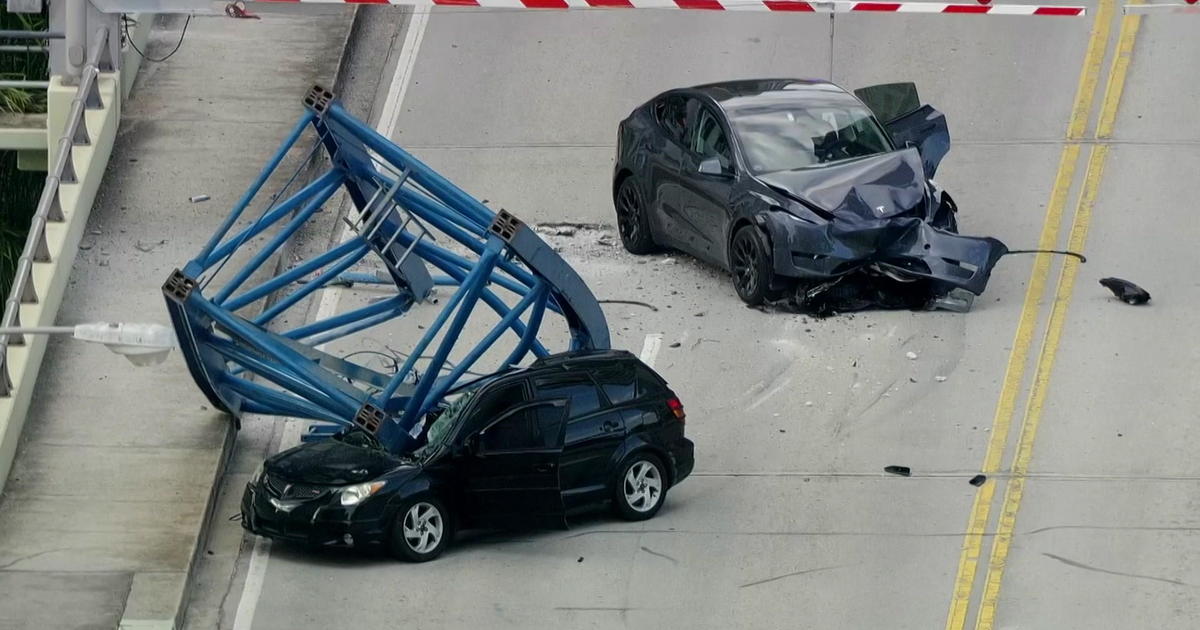NTSB To Hold Meeting On Cause Of FIU Bridge Collapse
MIAMI (CBSMiami/AP) – The National Transportation Safety Board has announced it will hold a meeting to discuss the cause of the FIU bridge collapse.
The NTSB released nearly 6,300 pages of reports Tuesday examining the role of each contractor in the construction of the pedestrian bridge at Florida International University that collapsed March 15, 2018.
NTSB says the Florida Department of Transportation listed the company Louis Berger Group, Inc. on a website-generated report as prequalified to evaluate the construction of a complex concrete bridge. FDOT told investigators it was a "technical error" on its website, as the company was not actually allowed to review that project.
In emails between FDOT representatives and an NTSB investigator, the state's transportation department said firms involved in the project should not have simply relied on the website as proof of Louis Berger's credentials, and should have done their own due diligence, such as seeing an actual letter of qualification from the state.
Furthermore, Louis Berger should have known whether it was qualified for the work, FDOT's special counsel Latasha Johnson wrote in an email to an NTSB investigator.
The level of qualification for that project required companies to have at least three professional engineers registered with the Florida State Board of Professional Engineers, and a minimum of five years of structural concrete bridge design experience.
FDOT told NTSB that Louis Berger never received the qualification that pedestrian bridge required. The company lost a qualification it had for less complex bridge designs in December 2016 because they lost some of their engineers.
Louis Berger did not immediately respond to a request for comment. The company that designed the bridge, FIGG Bridge Engineers, Inc., said in a response to NTSB findings that there was no disclosure on the state website saying firms shouldn't rely on its website.
Back in June, OSHA released a scathing report that revealed engineers knew there was extensive cracking and that 8th Street should have been shut down until repairs could be made.
The federal report states managers and engineers exchanged pictures of those cracks as early as February 28th, which was about two weeks before the collapse.
Here are some excerpts from OSHA's report:
- FIGG Bridge Engineers...failed to recognize that the bridge was in danger of collapsing when it inspected it hours before the collapse. The concrete truss had developed numerous wide and deep structural cracks jeopardizing the integrity of the bridge.
- The bridge had structural design deficiencies that contributed to the collapse during construction stage ...The cracks on the bridge occurred due to deficient structural design.
- The morning of the incident, EOR held a meeting with project participants ...The Construction Engineer and Inspector (CEI) of the project advised the EOR at this meeting that the cracks were lengthening daily. Despite these admissions and the knowledge that the cracks were growing in size, EOR stated more than once that the cracks did not present any safety concerns.
- EOR should have known that the truss was a non-redundant structure and if one diagonal member failed, the entire bridge could collapse. Given the nature and extent of the cracking and the non-redundancy of the bridge design, necessary safety precautions should have included closing the roadway below.
Will Watts, FDOT's chief engineer, said in a Sept. 20 letter to NTSB "the road should have been completely closed to all traffic if the contractor was undertaking activities that posed a risk to the public."
FIGG employees evaluated the cracks and said they didn't find safety concerns.
A Federal Highway Administration assessment released with the trove of documents on Tuesday found that FIGG "made significant errors," in its design calculations, leading to cracking that wasn't properly addressed.
The project was designed to look like a cable-stayed bridge, with steel pipes branching out from a tall mast. But it was never completed. Contractors used a method that avoids disrupting traffic by building bridge spans offsite and then transporting them to the location in a matter of hours.
Engineers began noticing cracks soon after the 174-foot-long (53-meter) span was put in place on March 10, 2018, days before the collapse. A crew was on the bridge working on tightening a diagonal beam the day it collapsed onto traffic.
In a statement, which you can read in full here, FIGG Bridge Engineers pointed the blame at contractors.
Six people died and 10 others were injured in the bridge collapse.
The NTSB's meeting is set for October 22nd in Washington.
(© Copyright 2019 CBS Broadcasting Inc. All Rights Reserved. The Associated Press contributed to this report.)



